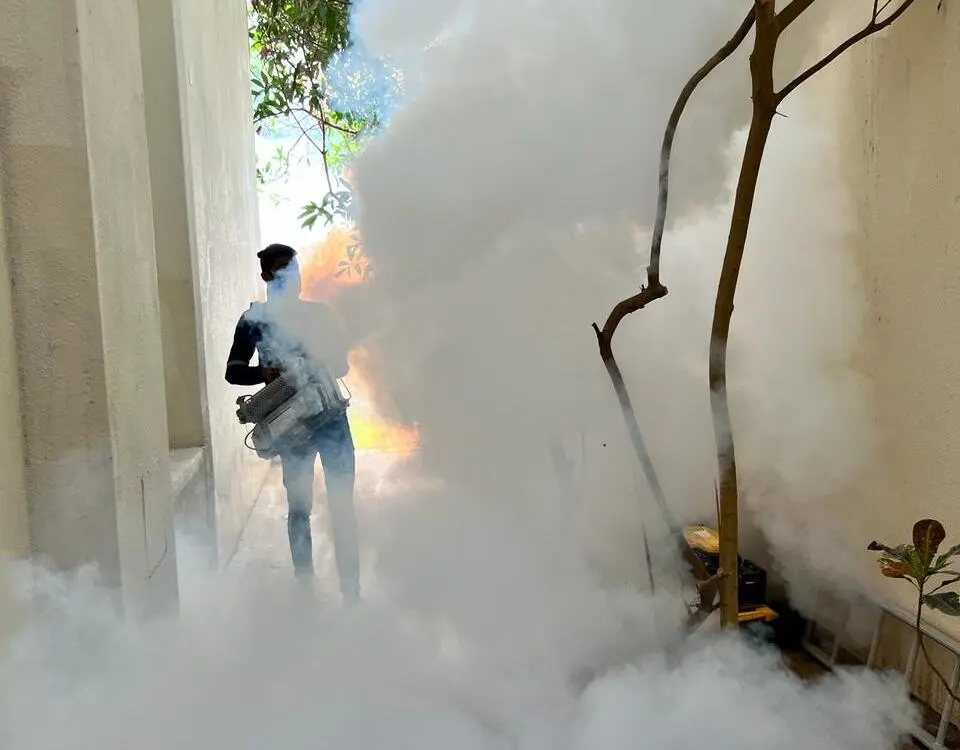What is fumigation?
Fumigation is a pest control method that involves using gaseous pesticides, known as fumigants. To eliminate pests within a sealed space. Unlike other pest control methods that target pests on the surface. Fumigation penetrates deep into cracks, crevices, and other inaccessible areas where pests may be harboring. This makes it highly effective for eradicating a wide range of pests, including insects, rodents, and even wood-destroying organisms like termites. During fumigation pest services, the area to be treated is enclosed with specialized tarps, tents, or other sealing materials to create an airtight environment. The fumigant is then introduced into the space in carefully controlled concentrations, where it permeates the air and reaches all areas within the structure. The fumigant works by suffocating pests, disrupting their metabolic processes, or interfering with their nervous systems, ultimately leading to their elimination.
Fumigation companies in Dubai are commonly used in various settings, including residential homes, commercial buildings, warehouses, shipping containers, and agricultural facilities. It is particularly useful for controlling widespread infestations, treating inaccessible areas, and preventing the spread of pests between locations.
Importance of fumigation pest services
Fumigation pest services play a pivotal role in pest control by offering a comprehensive and highly effective solution for eliminating pests in various settings. Its ability to penetrate deep into cracks, crevices, and inaccessible spaces ensures the eradication of pests at all life stages, making it particularly valuable for tackling stubborn infestations. Moreover, fumigation’s versatility extends to a wide range of pests, including insects, rodents, and wood-destroying organisms like termites, making it suitable for diverse environments such as residential homes, commercial buildings, warehouses, and agricultural facilities. Additionally, fumigation serves as a preventive measure to safeguard properties from potential infestations and provides long-lasting results with minimal disruption to occupants and operations. Its regulatory compliance in industries such as food processing underscores its importance in maintaining sanitation standards and protecting public health.
Understanding the Fumigation Process: Step-by-Step.
Fumigation pest services is a highly effective method for eliminating pests from enclosed spaces, but understanding the process is crucial for its success. Here’s a step-by-step guide to help you grasp what happens during a fumigation treatment:
1. Inspection and Assessment:
The process begins with a thorough inspection of the premises by trained pest control professionals. They assess the extent of the infestation, identify the type of pests present, and determine the appropriate fumigant and dosage needed for treatment.
2. Preparation:
Before fumigation begins, occupants must evacuate the premises, and all living beings, including pets and plants, must be removed or properly sealed in special cases. Additionally, any food, medications, and sensitive items that cannot be sealed or removed must be double-bagged in special fumigation bags or containers.
3. Sealing:
Once the area is cleared, the structure or space to be fumigated is sealed tightly to prevent the fumigant from escaping into the environment. This may involve covering windows, doors, vents, and other openings with specialized materials such as plastic sheets and tape.
4. Introduction of Fumigant:
With the area sealed, the fumigation team introduces the fumigant into the space using specialized equipment such as gas cylinders or generators. The fumigant is released in carefully calculated amounts to ensure thorough penetration and distribution throughout the infested area.
5. Exposure Period:
After introducing the fumigant, the area remains sealed for a specified period, known as the exposure or treatment time. During this time, the fumigant works to penetrate deep into cracks, crevices, and other hiding places where pests may be harboring, effectively eradicating them.
6. Aeration:
Once the exposure period is complete, the fumigation pest services team begins the aeration process to remove residual fumigants from the treated area safely. This typically involves ventilating the space with fans and opening windows and doors to allow fresh air to circulate and the fumigant to dissipate.
7. Post-Fumigation Inspection:
After aeration, the pest control professionals conduct a thorough inspection to ensure that the fumigation was successful and that no traces of fumigant remain. They may use specialized equipment such as gas detectors to confirm that the area is safe for re-entry.
8. Re-Entry:
Once the area has been deemed safe, occupants can re-enter the premises. Depending on the type of fumigant used and local regulations, a waiting period may be necessary before re-entry is permitted.
Fumigation pest services in Dubai
Fumigation services in Abu Dhabi are vital for maintaining pest-free environments in homes, businesses, and industrial facilities throughout the city. With Dubai’s warm climate and bustling urban landscape, pests such as insects, rodents, and termites can pose significant threats to property and public health. Fumigation offers a powerful solution by effectively penetrating deep into structures to eradicate pests at all life stages, ensuring thorough elimination. Professional fumigation pest services in Dubai employ trained technicians with state-of-the-art equipment and adhere to strict safety standards to deliver effective and reliable results. Whether it’s safeguarding residential homes from termite infestations or protecting commercial warehouses from stored product pests, fumigation services Dubai play a crucial role in preserving the cleanliness, safety, and integrity of properties across

